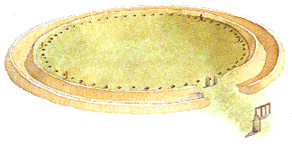About 80 miles west of London on what is known as the Salisbury Plain
lies a unique megalithic monument, unlike any other, named Stonehenge.
Isolated on a windswept plain in southern England, built by people who
left no written records, Stonehenge challenges our imaginations. Who really
built Stonehenge, and why? No one really knows the answers to these questions,
but there are many theories behind the mystery of Stonehenge.
During the
12th century, many of the people who visited Stonehenge believed magicians
had erected the great stones. They could not imagine that humans unaided
by magical power could have built such a great monument. To them only Merlin,
the mightiest of the magicians, could have performed such an awesome feat.
Legend has it that the King of England wanted a memorial site that would
last forever, for the slain princess. The British defeated the Irish and
won possession of the stones, but unfortunately all of the King's men could
not budge them. Merlin came to their rescue. Using his own "machine"
he simply laid the stones down in England (Roop; 25).
Another medieval
legend suggests that the devil built Stonehenge. According to the fable,
the stones had been on a woman's property in Ireland. The devil made the
women believe that he would buy the stones for a great amount of money,
but when the women looked at the place where the stones had stood, they
were gone. The devil had already spirited them away to England, placing
them on Salisbury Plain (Roop; 32).
It has also been argued that aliens
built Stonehenge. In the 1940's, Dr. Richard Stankowitz, from England,
claimed to have been abducted by aliens. Aboard their ship, Stankowitz
saw what he thought was an exact replica of Stonehenge. Afterwards, he
worked his entire life to prove his theory, but never found any solid evidence
(Hawkins; 5).
By the time that Julius Caesar came to England, the stones
were being used by the Druids, a native priesthood. Thus the legend that
the Druids had built Stonehenge persisted. We now know that the Druids
belonged to the last century B.C., while the first Phase of Stonehenge
came much earlier (Crouch; 7-8).
There are many other theories as to how
Stonehenge was built but not any have been proven. From archaeological
digs we now know that many of the stones came from Wales. What we still
don't know is why Stonehenge was built. Many astronomical experts believe
that Stonehenge was used as a kind of calendar to predict the phases of
the moon and the sun.
Stonehenge's construction is generally thought to
have been spread out through three phases over a 2000 year period from
around 3000 B.C. to 1000 B.C. (Hawkins: 39). The great stone circles and
horseshoe arrangements, which most everyone associates with Stonehenge,
were not added until the third phase. Surprisingly the original monument
was quite simple and is thought to have been built precisely enough to
predict both lunar and solar eclipses.

The original Stonehenge was a circular
ditch with an internal bank. The circular bank was about 320 feet in diameter.
Inside the bank was another circle of 56 holes known as the Aubrey Holes.
Four small stones, called the Station Stones, set at the corners of the
bank close to the Aubrey Holes. Outside the circle stood a 35-ton stone,
called the Heel Stone. For many reasons the original Stonehenge is thought
to be more than just a temple, it was an astronomical calculator (Crouch;
10-12).
One fact that backs up this theory is the monument was oriented
so that on midsummer's morning the sun rose directly over the Heel Stone
and the first rays shone into the center of the circular pattern. It was
argued that the summer solstice alignment could not be accidental. For
the alignment to be correct, it must have been calculated precisely for
Stonehenge's latitude of 51°11' (Hawkins; 155).
Another detail lies
in the number of Aubrey Holes. By moving a marker by two holes each day,
the cycle of the 56 holes would be completed in 28 days. In this way it
is possible to keep track of the 27.3 day cycle of the moon. Another calculation
is to move the marker by three holes per year to complete a full circuit
in 18.67 years. The sun and moon intersect every 18.61 years at the Nodes.
To keep track of the sun, one would merely have to move a marker by one
hole every 6.5 days. This would take 364 days to move around the Aubrey
Holes. By keeping track of the position of the Sun, Moon, and the nodes
on the Aubrey circle, the astrologers at Stonehenge could have predicted
eclipses fairly accurately. (Hadingham; 88-91).
Every day new theories
arise as to how and why Stonehenge was built. This is a question which
will intrigue experts for centuries to come. Unless we can somehow stand
in the footsteps of the people of Stonehenge, we will never answer all
of the riddles about it. Still, the great silent stones challenge us to
try to unravel their secrets.
